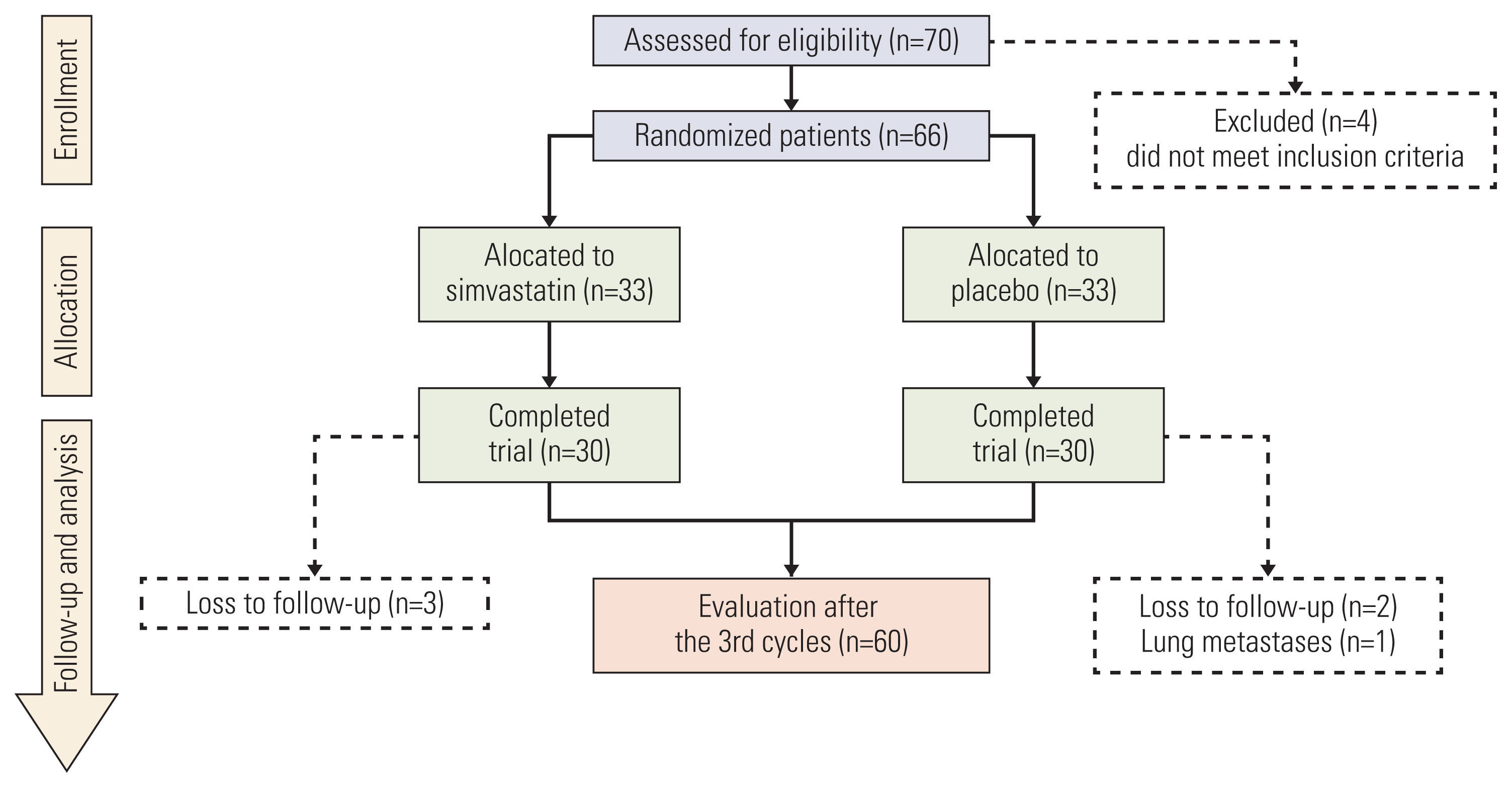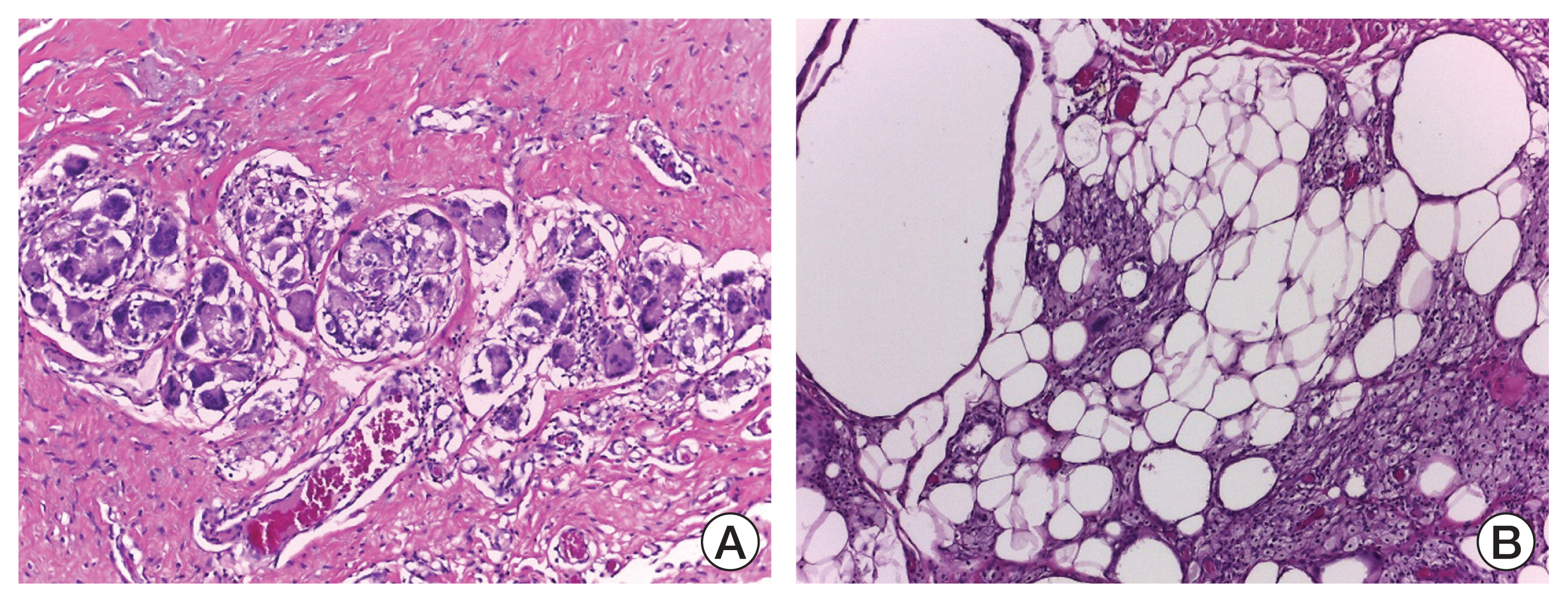Cancer Res Treat.
2021 Oct;53(4):1072-1083. 10.4143/crt.2020.1024.
Combination of Simvastatin and FAC Improves Response to Neoadjuvant Chemotherapy in Locally Advanced Breast Cancer
- Affiliations
-
- 1Division of Surgical Oncology, Department of Surgery, Dr. Cipto Mangunkusumo General Hospital, Faculty of Medicine, Universitas Indonesia, Jakarta, Indonesia
- 2Department of Pathology, Dr. Cipto Mangunkusumo General Hospital, Faculty of Medicine, Universitas Indonesia, Jakarta, Indonesia
- 3Department of Surgery, Koja General Hospital, Jakarta, Indonesia
- KMID: 2521582
- DOI: http://doi.org/10.4143/crt.2020.1024
Abstract
- Purpose
The efficacy of neoadjuvant chemotherapy for locally advanced breast cancer (LABC) is limited due to drug resistance and cardiotoxic effects. Preclinical studies have shown that statin induces apoptosis and decreases breast cancer cell growth. This study aims to evaluate the role of statin in combination with fluorouracil, adriamycin, and cyclophosphamide (FAC) therapy in LABC patients.
Materials and Methods
We undertook a randomized, double-blinded, placebo-controlled trial in two centers of Indonesia. Patients were randomly assigned to FAC plus simvastatin (40 mg/day orally) or FAC plus placebo (40 mg/day) for 21 days. The FAC regimen was repeated every 3 weeks. We evaluated the clinical response, pathological response, and toxicities.
Results
The objective response rate (ORR) for FAC plus simvastatin was 90% (95% confidence interval [CI], 0.99 to 1.67) by per-protocol analysis. No complete responses (CR) were recorded, but there were 48 partial responses. No significant difference was observed between the two groups with the ORR (p=0.103). The pathological CR rate was 6.25% (2 in simvastatin group and 1 in placebo group). Adverse events in both arms were generally mild, mainly consisted of myotoxicity. Human epidermal growth factor receptor 2 (HER2) expression was a factor related to the success of therapeutic response (odds ratio, 4.2; 95% CI, 1.121 to 15.731; p=0.033).
Conclusion
This study suggests that simvastatin combined with FAC shows improvements in ORR and pathological response in patients with LABC. Although no statistically significant difference was documented, there was a trend for better activity and tolerability. The addition of 40 mg simvastatin may improve the efficacy of FAC in LABC patients with HER2 overexpression.
Keyword
Figure
Reference
-
References
1. Rahman MS, Akhter PS, Hasanuzzaman M, Rahman J, Bhattacharjee A, Rassell M, et al. Outcome of neoadjuvant chemotherapy in locally advanced breast cancer: a tertiary care center experience. Bangladesh Med J. 2017; 45:141–6.
Article2. Bonadonna G. Evolving concepts in the systemic adjuvant treatment of breast cancer. Cancer Res. 1992; 52:2127–37.3. Fisher ER, Wang J, Bryant J, Fisher B, Mamounas E, Wolmark N. Pathobiology of preoperative chemotherapy: findings from the National Surgical Adjuvant Breast and Bowel (NSABP) protocol B-18. Cancer. 2002; 95:681–95.4. Bolan PJ, Wey A, Eberly LE, Nelson MT, Haddad TC, Yee D, et al. Assessing prognosis and therapy response in primary systemic therapy of breast cancer with magnetic resonance spectroscopy. Cancer Res. 2012; 72:P1-14-11.5. Szakacs G, Paterson JK, Ludwig JA, Booth-Genthe C, Gottesman MM. Targeting multidrug resistance in cancer. Nat Rev Drug Discov. 2006; 5:219–34.
Article6. Altwairgi AK. Statins are potential anticancerous agents (review). Oncol Rep. 2015; 33:1019–39.
Article7. Hindler K, Cleeland CS, Rivera E, Collard CD. The role of statins in cancer therapy. Oncologist. 2006; 11:306–15.
Article8. Jang HJ, Hong EM, Park SW, Byun HW, Koh DH, Choi MH, et al. Statin induces apoptosis of human colon cancer cells and downregulation of insulin-like growth factor 1 receptor via proapoptotic ERK activation. Oncol Lett. 2016; 12:250–6.
Article9. Khanzada UK, Pardo OE, Meier C, Downward J, Seckl MJ, Arcaro A. Potent inhibition of small-cell lung cancer cell growth by simvastatin reveals selective functions of Ras isoforms in growth factor signalling. Oncogene. 2006; 25:877–87.
Article10. Kozar K, Kaminski R, Legat M, Kopec M, Nowis D, Skierski JS, et al. Cerivastatin demonstrates enhanced antitumor activity against human breast cancer cell lines when used in combination with doxorubicin or cisplatin. Int J Oncol. 2004; 24:1149–57.
Article11. Garwood ER, Kumar AS, Baehner FL, Moore DH, Au A, Hylton N, et al. Fluvastatin reduces proliferation and increases apoptosis in women with high grade breast cancer. Breast Cancer Res Treat. 2010; 119:137–44.
Article12. Yulian ED, Ramli M, Setiabudy R, Siregar NC, Bustami A, Dosan R. The role of simvastatin in inhibiting migration and proliferation of breast cancer cells through Rho/ROCK signaling pathway. J Cancer Ther Res. 2016; 5:10.
Article13. An X, Xu F, Luo R, Zheng Q, Lu J, Yang Y, et al. The prognostic significance of topoisomerase II alpha protein in early stage luminal breast cancer. BMC Cancer. 2018; 18:331.
Article14. Bosco EE, Mulloy JC, Zheng Y. Rac1 GTPase: a “Rac” of all trades. Cell Mol Life Sci. 2009; 66:370–4.
Article15. Pathak M, Deo SV, Dwivedi SN, Sreenivas V, Thakur B. Total preoperative NACT vs sandwich NACT in breast cancer patients: systematic review and meta-analysis. Eur J Cancer. 2017; 72:S43.
Article16. Yoshida T, Zhang Y, Rivera Rosado LA, Chen J, Khan T, Moon SY, et al. Blockade of Rac1 activity induces G1 cell cycle arrest or apoptosis in breast cancer cells through downregulation of cyclin D1, survivin, and X-linked inhibitor of apoptosis protein. Mol Cancer Ther. 2010; 9:1657–68.17. Sadeghi-Aliabadi H, Minaiyan M, Dabestan A. Cytotoxic evaluation of doxorubicin in combination with simvastatin against human cancer cells. Res Pharm Sci. 2010; 5:127–33.18. Yun UJ, Lee JH, Shim J, Yoon K, Goh SH, Yi EH, et al. Anti-cancer effect of doxorubicin is mediated by downregulation of HMG-Co A reductase via inhibition of EGFR/Src pathway. Lab Invest. 2019; 99:1157–72.
Article19. Werner M, Sacher J, Hohenegger M. Mutual amplification of apoptosis by statin-induced mitochondrial stress and doxorubicin toxicity in human rhabdomyosarcoma cells. Br J Pharmacol. 2004; 143:715–24.
Article20. Werner M, Atil B, Sieczkowski E, Chiba P, Hohenegger M. Simvastatin-induced compartmentalisation of doxorubicin sharpens up nuclear topoisomerase II inhibition in human rhabdomyosarcoma cells. Naunyn Schmiedebergs Arch Pharmacol. 2013; 386:605–17.
Article21. Osman AM, Al-Johani HS, Kamel FO, Ahmed OA, Huwait EA, Sayed-Ahmed M. 5-Fluorouracil and simvastatin loaded solid lipid nanoparticles for effective treatment of colorectal cancer cells. Int J Pharmacol. 2020; 16:205–13.22. Houssami N, Macaskill P, von Minckwitz G, Marinovich ML, Mamounas E. Meta-analysis of the association of breast cancer subtype and pathologic complete response to neoadjuvant chemotherapy. Eur J Cancer. 2012; 48:3342–54.
Article23. Rastogi P, Anderson SJ, Bear HD, Geyer CE, Kahlenberg MS, Robidoux A, et al. Preoperative chemotherapy: updates of National Surgical Adjuvant Breast and Bowel Project Protocols B-18 and B-27. J Clin Oncol. 2008; 26:778–85.
Article24. Marchio C, Sapino A. The pathologic complete response open question in primary therapy. J Natl Cancer Inst Monogr. 2011; 2011:86–90.
Article25. Sahoo S, Lester SC. Pathology of breast carcinomas after neoadjuvant chemotherapy: an overview with recommendations on specimen processing and reporting. Arch Pathol Lab Med. 2009; 133:633–42.
Article26. Parkin L, Paul C, Herbison GP. Simvastatin dose and risk of rhabdomyolysis: nested case-control study based on national health and drug dispensing data. Int J Cardiol. 2014; 174:83–9.
Article27. Corsini A, Bellosta S, Baetta R, Fumagalli R, Paoletti R, Bernini F. New insights into the pharmacodynamic and pharmacokinetic properties of statins. Pharmacol Ther. 1999; 84:413–28.
Article28. Riad A, Bien S, Westermann D, Becher PM, Loya K, Landmesser U, et al. Pretreatment with statin attenuates the cardiotoxicity of doxorubicin in mice. Cancer Res. 2009; 69:695–9.
Article29. Seicean S, Seicean A, Plana JC, Budd GT, Marwick TH. Effect of statin therapy on the risk for incident heart failure in patients with breast cancer receiving anthracycline chemotherapy: an observational clinical cohort study. J Am Coll Cardiol. 2012; 60:2384–90.30. Bobrowski D, Zhou L, Austin P, Arguelles OC, Amir E, Lee D, et al. Statins are associated with lower risk of heart failure after anthracycline and trastuzumab chemotherapy for early stage breast cancer. J Am Coll Cardiol. 2020; 75(11 Suppl 2):7.
Article31. Budman DR, Tai J, Calabro A. Fluvastatin enhancement of trastuzumab and classical cytotoxic agents in defined breast cancer cell lines in vitro. Breast Cancer Res Treat. 2007; 104:93–101.
Article
- Full Text Links
- Actions
-
Cited
- CITED
-
- Close
- Share
- Similar articles
-
- Neoadjuvant Chemotherapy with Docetaxel and Adriamycin in Breast Cancer; Clincopathologic Factors Influencing to Response Rate
- Correlation between Tumor Response to Neoadjuvant Chemotherapy and Patient Outcome in Breast Cancer
- The Effects of FAC neoadjuvant Chemotherapy in Locally Advanced and Bulky Cervical Cancer
- Pathologic Findings of Residual Tumor according to the Response Rate after Neoadjuvant Chemotherapy for Breast Cancer
- Clinical outcome and predictive factors for docetaxel and epirubicin neoadjuvant chemotherapy of locally advanced breast cancer



